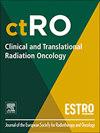质子束增强与保护同步一体化治疗肝癌的研究
IF 2.7
3区 医学
Q3 ONCOLOGY
引用次数: 0
摘要
目的:虽然质子束治疗(sibb - pbt)的同时整合增强和保护促进了肿瘤剂量的增加,同时维持了器官危险(OAR)的剂量限制,但临床结果有限。本研究评估了在肝细胞癌(HCC)患者中使用sibb - pbt技术的安全性和有效性。方法回顾了2014-2021年间47例接受ib - pbt治疗的HCC患者。辐射剂量从36 ~ 67.5 Gy(RBE)分为15个分量。使用sibb - pbt的原因如下:尽量减少高剂量暴露于危险器官(OARs) (n = 22,47 %),用不同剂量水平治疗目标(n = 6,13 %),或两者兼而有之(n = 19,40 %)。生存率、局部控制和毒性分别采用Kaplan-Meier、Fine-Gray累积发生率和描述性统计进行评估。结果41例(87%)患者肿瘤位于距肠管腔(GI) OARs≤2 cm处。中位肿瘤直径9.2 cm(范围2.0 ~ 21.5 cm)。总肿瘤体积中EQD2 D50%、D95%和D99%的中位值分别为79.8 Gy(51.1-85.9)、66.7 Gy(36.9-84.6)和50.2 Gy(34.1-83.6) Gy(RBE)10。大多数患者(91%)接受了0.5 cc的45 Gy(RBE)腹腔胃肠道OARs。中位随访22个月(0.8-77.0个月),2年累积局部失败发生率为12%。2年无进展生存率和总生存率分别为12% (95% CI 4.7 - 23.4%)和49% (95% CI, 33.2 - 63.2%)。1例患者出现3级急性恶心/呕吐。未观察到胃肠道出血/溃疡或4 +级毒性。5例出现CP + 2。结论:sibb - pbt具有OAR保护作用,同时具有肿瘤剂量递增的异质性,是一种安全有效的肝癌治疗方法。本文章由计算机程序翻译,如有差异,请以英文原文为准。
Simultaneous integrated boost and protection proton beam therapy approach for hepatocellular carcinoma
Purpose
Although simultaneous integrated boost and protection with proton beam therapy (SIB-PBT) facilitates tumor dose escalation while maintaining organ-at-risk (OAR) dose constraints, clinical outcomes are limited. This study assessed the safety and efficacy of using the SIB-PBT technique in hepatocellular carcinoma (HCC) patients.
Methods
We reviewed 47 patients with HCC who underwent SIB-PBT between 2014–2021. The radiation dose ranged from 36-67.5 Gy(RBE) in 15 fractions. SIB-PBT was used for the following reasons: minimize high-dose exposure to organs-at-risk (OARs) (n = 22, 47 %), treat targets with different dose levels (n = 6, 13 %), or both (n = 19, 40 %). Survival, local control, and toxicities were assessed using Kaplan-Meier, Fine-Gray cumulative incidence, and descriptive statistics, respectively.
Results
Forty-one patients (87 %) had tumors located ≤2 cm from luminal gastrointestinal (GI) OARs. The median tumor diameter was 9.2 cm (range, 2.0–21.5 cm). The median EQD2 D50%, D95% and D99% of gross tumor volume were 79.8 (range, 51.1–85.9), 66.7 (range, 36.9–84.6) and 50.2 (range, 34.1–83.6) Gy(RBE)10, respectively. Most patients (91 %) received a D0.5 cc of <45 Gy(RBE) to luminal GI OARs. At a median follow-up of 22 months (range, 0.8–77.0 months), the 2-year cumulative incidence of local failure was 12 %. The 2-year progression-free survival and overall survival rates were 12 % (95 % CI 4.7–23.4 %), and 49 % (95 % CI, 33.2–63.2 %), respectively. One patient experienced grade 3 acute nausea/vomiting. No GI bleeding/ulcers or grade 4 + toxicity were observed. CP + 2 occurred in 5 patients.
Conclusion
SIB-PBT enables OAR protection along with heterogeneous tumor dose escalation and is a safe and effective treatment for HCC tumors.
求助全文
通过发布文献求助,成功后即可免费获取论文全文。
去求助
来源期刊

Clinical and Translational Radiation Oncology
Medicine-Radiology, Nuclear Medicine and Imaging
CiteScore
5.30
自引率
3.20%
发文量
114
审稿时长
40 days
 求助内容:
求助内容: 应助结果提醒方式:
应助结果提醒方式:


